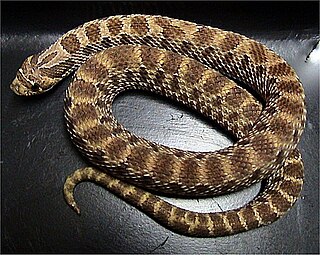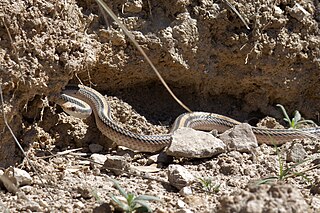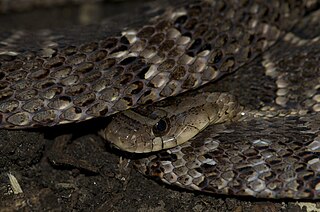
Macrovipera lebetinus, known as the blunt-nosed viper, Lebetine viper, Levant viper, and by other common names, is a viper species found in North Africa, much of the Middle East, and as far east as Kashmir. Like all other vipers, it is venomous. Five subspecies are currently recognized, including the nominate race described here.

Gerarda prevostiana, commonly known as the cat-eyed water snake, Gerard's water snake, and the glossy marsh snake, is a species of snake in the family Homalopsidae. The species is endemic to Asia. It is the only species in the genus Gerarda.

The long-nosed snake is a species of nonvenomous snake in the family Colubridae. The species is endemic to North America. It has two recognized subspecies. The other species in the genus were previously considered subspecies.

Heterodon is a genus of harmless colubrid snakes endemic to North America. They are stout with upturned snouts and are perhaps best known for their characteristic threat displays. Three species are currently recognized. Members of the genus are commonly known as hognose snakes, hog-nosed snakes, North American hog-nosed snakes, and colloquially puff adders.

The eastern hog-nosed snake, is a species of mildly venomous rear-fanged snake in the family Colubridae. The species is endemic to North America. There are no subspecies that are recognized as being valid. This species prefers habitats with sandy soils and a combination of grass fields and forest edges. They come in many different colorations and have the identifiable upturned "snout". They can be found in captivity but are a more difficult species to keep due to a specialized diet of toads.

Gyalopion is a genus of small nonvenomous colubrid snakes. Species in the genus Gyalopion are commonly referred to as hooknose snakes, and are native to the southwestern United States and Mexico.

Cemophora coccinea, commonly known as the scarlet snake, is a species of nonvenomous snake in the family Colubridae. The species is native to the southeastern United States. There are two subspecies of C. coccinea that are recognized as being valid. The Texas scarlet snake was previously considered a subspecies.
Hypsiglena torquata, the night snake, is a species of rear-fanged colubrid. It is found in Mexico.

Ficimia streckeri, also commonly known as the Mexican hooknose snake, the Tamaulipan hooknose snake, and the Texas hook-nosed snake, is a small species of snake in the family Colubridae. The species is native to northeastern Mexico and adjacent southern Texas.

Coluber constrictor oaxaca, commonly known as the Mexican racer, is a nonvenomous colubrid snake, a subspecies of the eastern racer.

Rhinocheilus lecontei tessellatus is a subspecies of nonvenomous colubrid snake, which is native to the western United States and northern Mexico.

The western hognose snake is a species of snake in the family Colubridae. The species is endemic to North America. There are three subspecies that are recognized as being valid, including the nominotypical subspecies.

Gyalopion canum, commonly known as the Western hooknose snake, is a species of small colubrid snake endemic to the deserts of the United States and Mexico. It is sometimes referred to as the Chihuahuan hook-nosed snake because it is commonly found in the Chihuahuan Desert.
Eryx elegans is a boa species endemic to western Central Asia. Like all other boas, it is not venomous. No subspecies are recognized.

Salvadora hexalepis, the western patch-nosed snake, is a species of non-venomous colubrid snake, which is endemic to the southwestern United States and northern Mexico.

Scaphiophis is a genus of African snakes in the family Colubridae. Common names include hook-nosed snakes and shovel-nosed snakes.

Xenodon rabdocephalus, commonly known as the false fer-de-lance, is a species of mildly venomous rear-fanged snake in the family Colubridae. The species is native to Central America and northern South America. There are two recognized subspecies.

Prosymna is a genus of elapoid snake. It is the only genus in the family Prosymnidae. They were formerly placed as a subfamily of the Lamprophiidae, but have been more recently identified as a distinct family.
Conopsis is a genus of snakes in the family Colubridae. The genus is endemic to Mexico.

Ficimia hardyi, also known commonly as Hardy's hooknose snake, Hardy's hook-nosed snake, the Hidalgo hook-nosed snake, and nariz de gancho de Hardy in Mexican Spanish, is a species of nonvenomous snake in the family Colubridae. The species is endemic to Mexico.
















